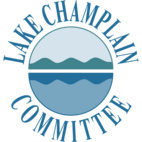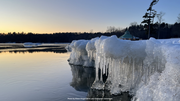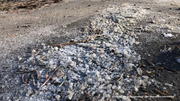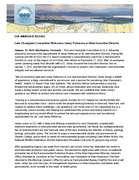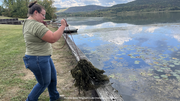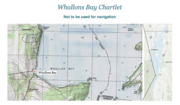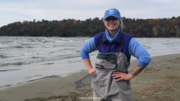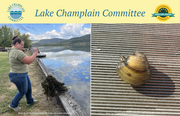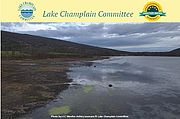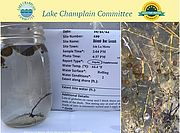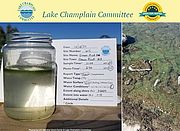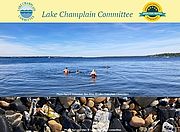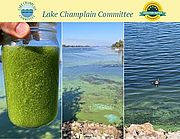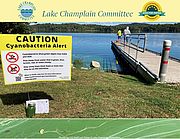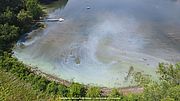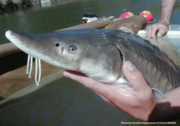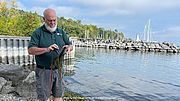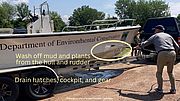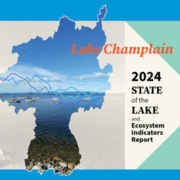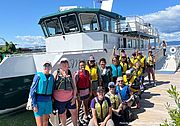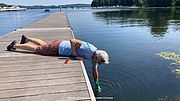When temperatures drop low enough to freeze wide stretches of Lake Champlain, the landscape takes on a new character. Ice replaces rolling waves, creating a surface that invites exploration—whether by skaters gliding across its glassy expanse or anglers setting up for the season. Beneath the frozen surface, life continues, with some species thriving in the cold while others slow down. Read...
News from Selected Month
It’s a familiar winter symphony in the Lake Champlain basin: snow, ice, and coarse rock salt crunch beneath your boots as you walk down the pavement. However, below the caked layers of snow, a quieter crisis is unfolding. Spreading road salt in pursuit of safer roads and sidewalks produces a cascade of unintended consequences that persist long after winter is over, corroding bridges, damaging roads, and compromising water systems.
Seeing road salt and other additives being spread on winter roads is nothing new. Yet it raises an important question: why can’t we put our roads on a low-sodium diet? Read...
The Lake Champlain Committee (LCC) is extremely pleased to announce the appointment of Jenny Patterson as its new Executive Director. During the summer and fall of 2024, the LCC Board conducted a comprehensive search for a new Executive Director to carry on the legacy of Lori Fisher, who retired on December 31, 2024, after an exemplary career spanning nearly four decades with LCC. Jenny assumed the Executive Director role on January 1, 2025, and will lead the organization’s mission to protect Lake Champlain’s environmental integrity and recreational resources. Read...

Join LCC at the World Water Day celebration!
March 22, 2025 is World Water Day, and LCC and our Champlain Basin Education Initiative partners are hosting a celebration at the Champlain Centre Mall in Plattsburgh, NY. All are welcome to attend, and K-12 students throughout the Lake Champlain Basin are invited to participate in a contest where awards are given for several categories of creative arts. Read...
While the sun shines in Montpelier, snow could be dumping from the clouds 50 miles southwest in Cornwall, VT. Apart from major snowstorms—namely Nor’easters—the formation of lake-effect snow over Lake Champlain is one of the weather patterns that turns the Champlain Valley into a winter wonderland. Lake-effect snows requires a big lake. This weather phenomenon is also common on the Great Lakes and New York’s Finger Lakes. Whether the snow makes you jump for joy or want to escape to warmer realms, it’s a staple of the winter experience in the Champlain watershed. Read...
Road salt has ripple effects on aquatic ecology, human health, and infrastructure. Anti-icing—the practice of preparing your roads before a freeze rather than salting your roads after ice—helps keep your driveway safe while using significantly less salt. Anti-icing before a storm is similar to using a non-stick spray on a pan before cooking: just as the spray prevents food from bonding to the pan, anti-icing prevents snow and ice from bonding to the pavement so that it can be plowed away. This approach can help you cut salt application in half. The steps outlined below, adapted from New Hampshire’s Best Management Practices for anti-icing by Axiomatic and from The Conservation Foundation, will help you take this approach at home and cut back on salt. Read...
In stressful times, one may envy a turtle: built-in safety from predators with their shells and free from modern expectations of speed and efficiency. Spending summers lounging on logs and rocks warmed by the sun and winters in seemingly peaceful hibernation. However, the winter months present survival obstacles for all animals in Lake Champlain, and turtles don’t have it easy. While hibernation may seem appealing to those who don’t enjoy the long cold nights of the season, it poses challenges with some surprising solutions. Read...
On a sunny late-October day, a dual-sided rake head tied to a twenty-five-foot length of rope sailed through the air and broke the previously still water of a boat launch in Whitehall, New York with a splash. Ashley Leemans, a volunteer with the Lake Champlain Committee (LCC), reeled in the rope, and picked through the pounds of submersed plants that collected on the tines to identify what species are present. It’s a part of routine monitoring for volunteers in LCC’s Champlain Aquatic invasive Monitoring Program—CHAMP—where participants are trained to survey for invasive species, both those that have been detected in Lake Champlain and those that have been found in nearby waterbodies on the “watchlist”. While sifting through her first rake toss of the day, Ashley found something alarming. Read...
Given the recent election, national politics is on many people’s minds. Unfortunately, the protection of something as fundamental as water has become a political issue. The Clean Water Act (CWA) turned 52 in late October 2024. The Act shaped water policy in the United States and helped restore the quality of our country’s waters, but much has changed since its passage and recent court rulings have weakened its reach. Read...
Sobagwihla --soo-bah-gwee-hlah--where sea ducks gather, where it becomes ocean. That’s the Western Abenaki place name and the meaning of Kill Kare, one of the Lake Champlain Paddlers’ Trail sites. A bill that passed the Vermont Legislature in 2020 that LCC supported required that any new state park signs display both the English name and Abenaki name, if there is one. Preliminary work to identify site names was completed in October 2024 and we’ve added them to the Lake Champlain Paddlers’ Trail guidebook in recognition that the Trail exists on territory originally and currently inhabited by Abenaki and other native people. We hope to add more place names in the future. Read...
LCC welcomed Dr. Lindsey Carlson as our Water and Science Program Coordinator on 12/16/24. “Lindsey brings a wealth of experience in aquatic ecology, community engagement, and environmental science to the LCC team,” noted LCC Executive Director Lori Fisher. “We’re delighted to have her on board to oversee our cyanobacteria and aquatic invasive monitoring programs and expand the Lake Champlain Paddlers’ Trail.” Read...
They touch the tips of swimmers’ toes, wrap around fishhooks, anchors, and paddles, and form underwater meadows near shorelines—native aquatic plants are ubiquitous in Lake Champlain Basin waterbodies. The roles these aquatic superstars play in lake ecosystems are often undervalued. It is not uncommon to hear native aquatic plants described as “yucky weeds,” but they are so much more than that—each species tells their own unique evolutionary story, and each plays a role in the broader ecological and human systems of Lake Champlain. Underwater flora are frequently overlooked, yet they are as essential as trees in a forest.
Not only are these plants ecologically important—they’re beautiful! If you have a space like a gallery, library, classroom, or meetinghouse, you can add educational and artistic flair to your walls with our art prints of native aquatic plants. LCC has sets of fifteen prints showcasing the Lake Champlain flora that you can borrow for display, along with a suite of accompanying educational materials including factsheets, identification cards, informative articles, and more. Read...
In late October Lake Champlain Committee (LCC) community science volunteer Ashley Leemans tossed an aquatic rake into Lake Champlain and pulled in a clam while doing a routine monitoring check for aquatic invasive species (AIS) at the South Bay Boat Launch in Whitehall, New York. Ashley immediately reported her finding complete with photos to LCC and we followed up with the Lake Champlain Basin Program (LCBP) and state agencies who conducted further analysis and confirmed our suspicions that the mollusk was golden clam (Corbicula fluminea). The aggressive AIS has been documented in the region since 2008, but the October 2024 sighting is the first known finding in Lake Champlain. Native to the eastern Mediterranean, Asia, Africa, and Australia golden clam is hermaphroditic, meaning a single individual can start a new population. The species is known to reproduce quickly in other North American waterbodies. Read...
Reports dwindled dramatically as we moved into November and head towards the 2024 season’s end in the middle of this month.
In this email you’ll find monitoring results from 11/3 – 11/9/24, resources to help you recognize and report cyanobacteria, and photographs of leaf litter, a bloom-free Magog, murky water at Whitehall, all clear at Alburgh, and week 21 bloom-free close-ups. Read...
When a volunteer pulled a suspicious clam from the lakebed in Whitehall, New York, as part of a routine monitoring program last month, they immediately reported the find to lake scientists. Further analysis confirmed the first known occurrence of invasive golden clam (Corbicula fluminea)in Lake Champlain. The volunteer, working with the Champlain Aquatic Invasive Species Monitoring Program (CHAMP), made the discovery while conducting a survey at the South Bay boat launch. Read more about the introduction in the press release from the Lake Champlain Basin Program. Read...
In this email you’ll find monitoring results from 10/27 – 11/2/24, resources to help you recognize and report cyanobacteria, and photographs of fall beauty at Blanchard Beach, a leafy scene, Eagle Bay solitude, wind and whitecaps at Leddy Beach, Lake Bomoseen in the clear, a crayfish in the shallows at Alburgh Dunes, murky Magog, beach bubbles, and week 20 bloom-free scenes. Read...
We’re in the last few weeks of monitoring for the 2024 season with far fewer reports coming in but there are still bloom sightings so check water conditions carefully especially if you’re recreating with pets. Read...
We have a far smaller cadre of community science volunteers checking monitoring sites this time of year so while we’re still receiving bloom reports our coverage both on Lake Champlain and inland waterways is greatly reduced. Read...
Lawns make up a large portion of the developed area in the Lake Champlain Basin and simple changes to mowing and fertilizing practices can reduce stormwater runoff and pollution. Although lawn maintenance tends to wind down this season, fall is an important time to consider practices that reduce water quality impacts and can improve the health of your lawn and soil for next summer and beyond.
Read on to learn about what you can do on your lawn to support water quality! Read...
The cooler fall temperatures reduced the number of bloom sightings but we also have far fewer monitors reporting this late in the season so blooms could have been missed due to lack of coverage. Read...
Over a third of the 91 monitoring reports received for Lake Champlain during week 16 chronicled blooms--only the Main Lake South and South Lake segments had no blooms reported. Lake Carmi and Shelburne Pond also had reports of blooms. While the season is winding down, cyanobacteria can still show up long into the fall. Read...
The number of monitoring reports received for Lake Champlain fell below 100 for the first time this year during week 15 and we only received 16 reports from inland VT waterways as more volunteers and state and municipal seasonal staff left lakeside posts. Calm, dry, and relatively warm weather helped stimulate or sustain some significant blooms in Lake Champlain’s Main Lake North and Inland Sea and Malletts Bay had bloom activity as well. Read...
Aquatic plants in Lake Champlain will be dying back soon, but their blooms provide additional color to the vibrant autumn landscape. How did aquatic plants in the lake get there, and what helps make them successful away from land? We dig into the origin of plants, their journey from water to land and back again, and some specific adaptations of plants found in the Lake Champlain basin. Read...
Aquatic plants in Lake Champlain will be dying back soon, but their blooms provide additional color to the vibrant autumn landscape. How did aquatic plants in the lake get there, and what helps make them successful away from land? We dig into the origin of plants, their journey from water to land and back again, and some specific adaptations of plants found in the Lake Champlain basin.
Lake sturgeon are fish with a lot of superlatives. They have been on Earth longer than any flowering plant, can grow to the standing height of an adult man, and live to be supercentenarians in the right conditions a complicated relationship with people as it was Nearly driven to extinction and currently designated as endangered in Vermont and threatened in New York, lake sturgeon have complicated relationships with people. Read on to learn about their storied evolutionary history, “vintage” features, and how they got to the precarious state they’re in now. Read...
Aquatic invasive species (AIS) are among the major challenges facing Lake Champlain—they reduce biodiversity by outcompeting native species and disrupting ecological processes, and they can proliferate to impact water quality and recreation. LCC launched a volunteer community science initiative—the Champlain Aquatic invasive Monitoring Program (CHAMP)—to train folks how to identify and survey for key AIS in Lake Champlain. We still need volunteers to survey before the snow flies—you can sign up on our website and we’ll schedule additional trainings in your area. Read on to learn more about the program and stories from the field. Read...
Humans are the main conveyors of most aquatic invasive species, moving them from one body of water to another. Many of these troublesome plants and animals can be unintentionally transported on fishing gear, boating equipment, or even tiny amounts of water left in a watercraft. The simplest and most effective way to prevent the spread of aquatic invasives is to ensure that your vessel and all your equipment are cleaned, drained, and dried.
In June 2024 the Lake Champlain Basin Program -- the entity that coordinates and helps fund implementation of the Lake Champlain restoration and management plan in partnership with New York, Vermont, and Quebec government agencies – released its 2024 State of the Lake Report. The 36-page document provides an update on how Lake Champlain is faring according to four goals of clean water, healthy ecosystems, informed and involved public, and thriving communities. It includes a “scorecard” showing data trends on phosphorus, cyanobacteria blooms, and the introduction of new invasive species and uses easy-to-understand graphics and maps to illustrate complex issues. Read on for a brief tour of the contents and some take-aways. Read...
The Lake Champlain basin is full of stories that educators can use to teach all subjects, engage students in learning about their community, and integrate content, service, and a sense of belonging to their home watershed. To delve into these stories with teachers, the Lake Champlain Committee and our partners in the Champlain Basin Education Initiative (CBEI) hosted a course called Watershed for Every Classroom (WEC). The place-based educational program in the Lake Champlain watershed is part professional development and part summer camp for teachers. Read...
Cyanobacteria naturally occurs in lakes and have existed on earth for millions of years. Under the right conditions they form large accumulations referred to as blooms. Some types produce toxins which release into the water especially when cyanobacteria die and break down. Not all cyanobacteria blooms are toxic, but since there is no way to tell if toxins are present without laboratory tests, it is always safest to avoid blooms and adhere to beach closures—when in doubt, stay out. Read...
